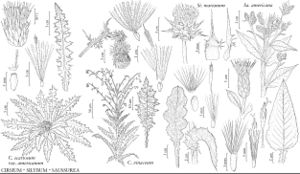Silybum marianum
Fruct. Sem. Pl. 2: 378. 1791.
Stems glabrous or slightly tomentose. Leaves: basal wing-petioled, blades 15–60+ cm, margins coarsely lobed; cauline leaves clasping, progressively smaller and less divided, bases spiny, coiled, auriculate. Phyllary appendages spreading, ovate, 1–4 cm including long-tapered spine tips. Corollas 26–35 mm; tubes 13–25 mm, throats campanulate, 2–3 mm, lobes 5–9 mm. Cypselae brown and black spotted, 6–8 mm; pappus scales 15–20 mm. 2n = 34.
Phenology: Flowering Feb–Jun (west), Jul–Sep (north).
Habitat: Roadsides, pastures, waste areas, sometimes cultivated
Elevation: 0–800 m
Distribution

Introduced; Alta., B.C., N.B., N.S., Ont., Que., Sask., Ala., Ariz., Ark., Calif., Conn., Ind., La., Mich., Miss., Nev., N.H., N.J., N.Mex., N.Y., N.C., Ohio, Oreg., Pa., Tenn., Tex., Vt., Va., Wash., W.Va., s Europe (Mediterranean region).
Discussion
Silybum marianum is sometimes cultivated as an ornamental, a minor vegetable, or as a medicinal herb. Young shoots can be boiled and eaten like cabbage and young leaves can be added to salads. The seeds can be used as a coffee substitute. Extracts of S. marianum are used as an herbal treatment for liver ailments.
Selected References
None.
